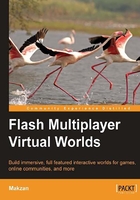
Preface
Back in the late 1970s, digital virtual world and multiuser adventure games, MUDs, made their debut. At the time Internet reached the masses and got popular in 1990s, Massively Multiplayer Online Games, MMOGs, became the new market that every game company was eager to get into. Players download or buy discs to install the online virtual world. The world gives players a virtual personality and they can play and interact with each other to finish tasks.
Being a multimedia and interaction platform, Adobe Flash introduced socket connection support to Flash player. The socket connection allows Flash player to connect persistently to a socket server and provide the opportunity for multiple user Flash applications. In other words, socket connection makes it possible to create a Flash online virtual world.
Compared to the traditional multiplayer online games, Flash online virtual worlds are browser-based and do not need any installation (except the Flash player plugin). They allow players to quickly play the virtual world game just like browsing a web page. The convenience fits the nature of Internet and thus can reach a larger variety of potential players.
Thanks to the quick evolution of socket networking service during these years, Flash online virtual worlds are becoming a trend. Every day users log into social networking sites and play with friends on their virtual farms or virtual towns.
With this book, we will have a step-by-step guide to create our own Flash virtual world from scratch. We will discuss several essential parts of creating a Flash virtual world and integrating it into social networking services. At last, we will have a look on how to deploy and operate our virtual world in production and earn money from it.